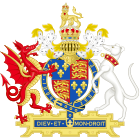| Act of Parliament | |
 | |
| Long title | An Act for Knights and Burgesses to have Places in the Parliament for the County Palatine and City of Chester |
|---|---|
| Citation | 34 & 35 Hen. 8. c. 13 |
| Territorial extent | Kingdom of England |
| Dates | |
| Royal assent | 12 May 1543 |
| Commencement | 1 October 1543 |
| Repealed | 30 July 1948 |
| Other legislation | |
| Repealed by | Representation of the People Act 1948 |
Status: Repealed | |
| Text of statute as originally enacted | |
The Chester and Cheshire (Constituencies) Act 1542 (34 & 35 Hen. 8. c. 13) is the act of Parliament allowing the county palatine of Cheshire in the Kingdom of England to be represented in the Parliament of England. The act was approved by royal assent of Henry VIII on 12 May 1543 and commenced into law on 1 October 1543. It was formally repealed by the Representation of the People Act 1948.
The earldom of Chester is traditionally vested in the sovereign's eldest son upon his crowning as Prince of Wales.
History
Chester was established as a county palatine by William the Conqueror after he gained control of the land following his victory at the Battle of Hastings in 1066. Between 1067 and 1070, William named his advocate Gerbod the Fleming as the first Earl of Chester, named for the city of Chester. Prior to 1543, Cheshire had its own parliament, consisting of barons of the county. After the law was commenced on 1 October 1543, Cheshire sent its first representatives to the Parliament of England.[1]
In 1832, the Cheshire constituency was abolished and replaced with constituencies for North Cheshire and South Cheshire. These constituencies were divided in 1868. The original Act was repealed by section 80 of, and Schedule 13 to, the Representation of the People Act 1948 (c.65), which was enacted on 30 July 1948.
Bibliography
- 34 & 35 Hen. 8. c. 13, An Act for Knights and Burgesses to have Places in the Parliament for the County Palatine and City of Chester — in Raithby, John; Tomlins, Sir Thomas Edlyne (1811). The statutes at large, of England and of Great Britain: from Magna Carta to the union of the kingdoms of Great Britain and Ireland, Volume 3: 1509–53. London: Printed by George Eyre and Andrew Strahan. (Full text of the Act as passed, from Google Books scan)
References
- ^ Sylvester, Dorothy (1980). A History of Cheshire (2nd ed.). London and Chichester: Phillimore. ISBN 0-85033-384-9.
